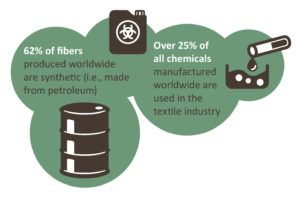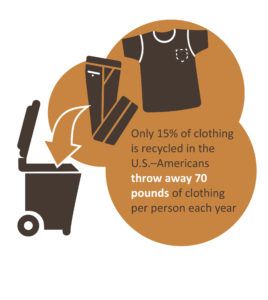Common Threads Report
Food & Fibers: Critical Players in an Interconnected System
Excerpted and Expanded from Common Threads: U.S. Foundation Opportunities in Sustainable Fiber and Textiles (July 2017)
Overview
U.S. funders and investors have played a key role in building a movement to re-localize and improve the sustainability of our food system. At the same time, a closely related and important part of the agricultural system has been largely overlooked: fiber and textile production. Food and fibers—including both plant-based fibers like cotton and hemp and animal-based products like wool and leather—are part of an interconnected system with many linked impacts on health, social justice, and the environment. Funders interested in the food system, sustainable agriculture, soil health, carbon sequestration, environmental health, and economic justice have many compelling reasons to expand their focus to the fiber and textile system.
Key Connections Between the Food and Fiber Systems
1| Food and fibers are critical for our daily needs and fundamental to human health.
Like food, textile products are part of our daily life. Clothing, mattresses, bedding, carpeting, and furniture touch our skin and affect the air we breathe through off-gassing of chemicals like flame retardants and formaldehyde. The types of fibers and dyes used and the methods of production and disposal impact the health of the end user, the producer, and the environment. We need to ask the same questions and challenge many of the same systemic issues for fibers as we do for food. For example: Where does this product come from? Who grew and processed this, and how were they treated? What chemicals were used on this? Where will this go when I am done with it?
2| The food and fiber systems are responsible for major and interconnected environmental impacts.
Fiber crops like cotton, flax, and hemp are often overlooked in discussions of the agricultural system, yet they are major contributors to agricultural economies and their environmental impacts. For example, cotton is grown on 2.3% of the world’s arable land, but it is responsible for 14% of agricultural insecticide use. While rangelands and grazing lands are increasingly studied for their carbon sequestration and climate mitigation potential in food systems work, textile industry connections such as sheep production for wool and leather as a byproduct of the cattle industry are rarely examined in these analyses. Agricultural water use and pollution and deforestation to produce wood-derived fibers like viscose and rayon are just a few other areas that call for integrated funding and investment approaches to food and fiber systems.
Looking Ahead
U.S. funders and investors currently have a key moment of opportunity to invest in the sustainable fiber and textile sector. U.S. consumer awareness is growing, new non-profits and for-profits are emerging in the sector, major apparel brands are refocusing on natural fibers and soil health, and new generation of U.S. farmers is focusing on textile crops such as hemp and wool. Working with established and emerging organizations in this growing field, U.S. foundations are well-positioned to draw on key lessons from the sustainable food movement and accelerate the development of a coordinated movement for clean, ethical, and sustainably-produced textiles as a force for environmental and social change.



 The increasing trend towards synthetic materials in both the food and fiber systems raises key questions about what can be considered
The increasing trend towards synthetic materials in both the food and fiber systems raises key questions about what can be considered The topic of food waste received little attention for the first few decades of the local food movement—until pioneering research by NRDC inspired the Fink Foundation to take a leadership role in the ReFED Project, galvanizing awareness of this issue. In the textile industry, the numbers are just as startling. Americans throw away an average of 70 pounds of clothing per person per year; less than 15% of textile waste is recycled in the U.S.; and a garbage truck load of textile and clothing waste is buried or burned every second. These waste streams contribute to GHG emissions and are driven by extractive production systems that prioritize corporate wealth. Funders can learn from work on food waste to integrate a circular approach to fiber system reform from the beginning.
The topic of food waste received little attention for the first few decades of the local food movement—until pioneering research by NRDC inspired the Fink Foundation to take a leadership role in the ReFED Project, galvanizing awareness of this issue. In the textile industry, the numbers are just as startling. Americans throw away an average of 70 pounds of clothing per person per year; less than 15% of textile waste is recycled in the U.S.; and a garbage truck load of textile and clothing waste is buried or burned every second. These waste streams contribute to GHG emissions and are driven by extractive production systems that prioritize corporate wealth. Funders can learn from work on food waste to integrate a circular approach to fiber system reform from the beginning.